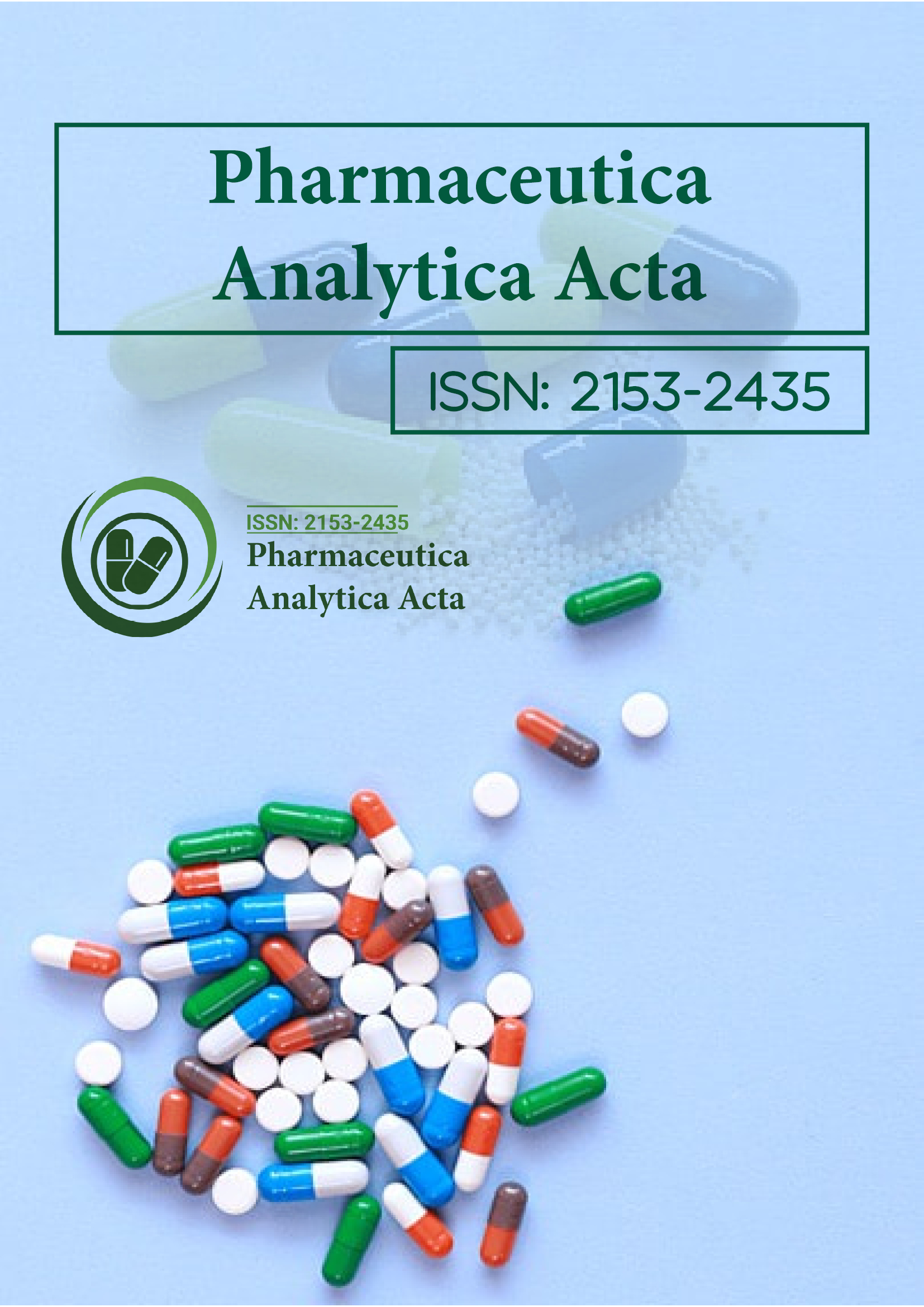ఇండెక్స్ చేయబడింది
- J గేట్ తెరవండి
- జెనామిక్స్ జర్నల్సీక్
- అకడమిక్ కీలు
- JournalTOCలు
- గ్లోబల్ ఇంపాక్ట్ ఫ్యాక్టర్ (GIF)
- చైనా నేషనల్ నాలెడ్జ్ ఇన్ఫ్రాస్ట్రక్చర్ (CNKI)
- ఉల్రిచ్ పీరియాడికల్స్ డైరెక్టరీ
- RefSeek
- హమ్దార్డ్ విశ్వవిద్యాలయం
- EBSCO AZ
- OCLC- వరల్డ్ క్యాట్
- పబ్లోన్స్
- జెనీవా ఫౌండేషన్ ఫర్ మెడికల్ ఎడ్యుకేషన్ అండ్ రీసెర్చ్
- యూరో పబ్
- గూగుల్ స్కాలర్
ఉపయోగకరమైన లింకులు
ఈ పేజీని భాగస్వామ్యం చేయండి
జర్నల్ ఫ్లైయర్

యాక్సెస్ జర్నల్స్ తెరవండి
- ఆహారం & పోషకాహారం
- ఇంజనీరింగ్
- ఇమ్యునాలజీ & మైక్రోబయాలజీ
- క్లినికల్ సైన్సెస్
- జనరల్ సైన్స్
- జెనెటిక్స్ & మాలిక్యులర్ బయాలజీ
- నర్సింగ్ & హెల్త్ కేర్
- న్యూరోసైన్స్ & సైకాలజీ
- పర్యావరణ శాస్త్రాలు
- ఫార్మాస్యూటికల్ సైన్సెస్
- బయోఇన్ఫర్మేటిక్స్ & సిస్టమ్స్ బయాలజీ
- బయోకెమిస్ట్రీ
- మెటీరియల్స్ సైన్స్
- మెడికల్ సైన్సెస్
- రసాయన శాస్త్రం
- వెటర్నరీ సైన్సెస్
- వ్యవసాయం మరియు ఆక్వాకల్చర్
- వ్యాపార నిర్వహణ
నైరూప్య
బయోఫీల్డ్ ట్రీట్ చేయబడిన O -అమినోఫెనాల్ యొక్క భౌతిక, ఉష్ణ మరియు వర్ణపట లక్షణాల లక్షణం
స్నేహసిస్ జానా, మహేంద్ర కుమార్ త్రివేది, రామమోహన్ తల్లాప్రగడ, అలిస్ బ్రాంటన్, దహ్రీన్ త్రివేది, గోపాల్ నాయక్ మరియు రాకేష్ కుమార్ మిశ్రా
O-అమినోఫెనాల్ ఒక వాహక పదార్థంగా మరియు ఎలెక్ట్రోకెమికల్ పరికరాలలో విస్తృతమైన ఉపయోగాలను కలిగి ఉంది. ఓ-అమినోఫెనాల్ యొక్క భౌతిక ఉష్ణ మరియు వర్ణపట లక్షణాలపై బయోఫీల్డ్ శక్తి చికిత్స యొక్క ప్రభావాన్ని పరిశోధించడం ఈ పరిశోధన యొక్క లక్ష్యం. అధ్యయనం రెండు సమూహాలలో నిర్వహించబడింది; నియంత్రణ సమూహం చికిత్స చేయబడలేదు, చికిత్స చేయబడిన సమూహం Mr. త్రివేది యొక్క బయోఫీల్డ్ శక్తి చికిత్సకు లోబడి ఉంది. తదనంతరం, నియంత్రణ మరియు చికిత్స చేయబడిన ఓ-అమినోఫెనాల్ నమూనాలు ఎక్స్-రే డిఫ్రాక్షన్ (XRD), డిఫరెన్షియల్ స్కానింగ్ క్యాలరీమెట్రీ (DSC), థర్మోగ్రావిమెట్రిక్ అనాలిసిస్ (TGA), ఉపరితల వైశాల్య విశ్లేషణ, ఫోరియర్ ట్రాన్స్ఫార్మ్ ఇన్ఫ్రారెడ్ (FT-IR) స్పెక్ట్రోస్కోపీ మరియు అల్ట్రా ద్వారా వర్గీకరించబడ్డాయి. వైలెట్-కనిపించే స్పెక్ట్రోస్కోపీ విశ్లేషణ (UV-vis). XRD విశ్లేషణ నియంత్రణకు సంబంధించి చికిత్స చేయబడిన ఓ-అమినోఫెనాల్ యొక్క గరిష్ట తీవ్రతలో పెరుగుదలను చూపించింది. అదనంగా, నియంత్రణ నమూనాకు సంబంధించి చికిత్స చేయబడిన ఓ-అమినోఫెనాల్ యొక్క స్ఫటికాకార పరిమాణం 34.51% పెరిగింది. DSC విశ్లేషణ నియంత్రణతో పోలిస్తే చికిత్స చేయబడిన నమూనా యొక్క ద్రవీభవన ఉష్ణోగ్రతలో స్వల్ప పెరుగుదలను చూపించింది. అయినప్పటికీ, నియంత్రణకు సంబంధించి 162.24% ద్వారా చికిత్స చేయబడిన ఓ-అమినోఫెనాల్లో కలయిక యొక్క గుప్త వేడిలో గణనీయమైన పెరుగుదల గమనించబడింది. TGA విశ్లేషణ నియంత్రణ (175ºC)కి సంబంధించి చికిత్స చేయబడిన o-అమినోఫెనాల్ (178.17ºC)లో గరిష్ట ఉష్ణ కుళ్ళిపోయే ఉష్ణోగ్రత (Tmax)లో పెరుగుదలను చూపింది. బయోఫీల్డ్ చికిత్స తర్వాత ఓ-అమినోఫెనాల్ యొక్క ఉష్ణ స్థిరత్వం పెరిగిందని ఊహించవచ్చు. BET ఉపయోగించి ఉపరితల వైశాల్య విశ్లేషణ నియంత్రణతో పోలిస్తే చికిత్స నమూనా యొక్క ఉపరితల వైశాల్యంలో 47.1% గణనీయమైన తగ్గుదలని చూపించింది. FT-IR విశ్లేషణ నియంత్రణకు సంబంధించి చికిత్స చేయబడిన నమూనా యొక్క శోషణ శిఖరాలలో ఎటువంటి మార్పులను చూపించలేదు. UV-కనిపించే విశ్లేషణ శోషణ శిఖరాలలో మార్పును చూపింది, అంటే 211→203 nm మరియు 271→244 nm చికిత్స చేయబడిన o-అమినోఫెనాల్ నియంత్రణతో పోలిస్తే. మొత్తంమీద, బయోఫీల్డ్ చికిత్స చికిత్స ఓ-అమినోఫెనాల్ యొక్క భౌతిక, ఉష్ణ మరియు వర్ణపట లక్షణాలలో మార్పుకు కారణమైందని ఫలితాలు చూపించాయి.